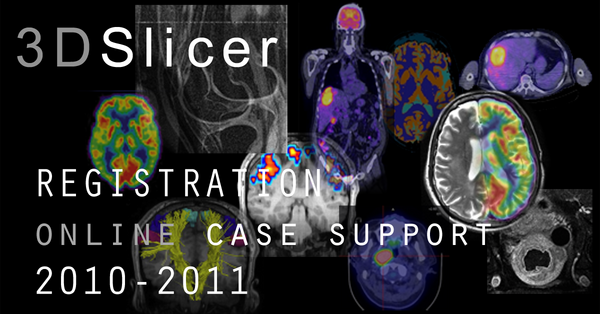Projects:RegistrationDocumentation:UseCaseAdvertisement
From NAMIC Wiki
Home < Projects:RegistrationDocumentation:UseCaseAdvertisement
back to Use Case Library
back to Registration Main Page
Contents
Registration in 3D Slicer- Call for Datasets for the Registration Case Library
Let us help you turn your registration problem into a success story. If you have an interesting or vexing registration problem that is not yet covered in the Library , send us your one case: we will try to register it for you and design a tailored registration approach you can use. We then add the anonymized data to the library and build a guided step-by-step tutorial for it. This is a time and resource limited service available until July 1, 2011.
What We Will Do
- we will seek the best possible registration obtainable with the most recent version of 3DSlicer.
- we will post the anonymized image data as a new case in our Slicer Registration Case Library. Your case will receive its own page, similar to this.
- the exact workflow of obtaining the registration will be posted alongside the data as a guided step-by-step tutorial
- the parameters for successful registration will also be posted as a loadable custom "Registration Preset" file that you can load directly into slicer and apply on your data
- if you can provide us with fiducial pairs or other criteria that define a good registration, we will use them in optimization efforts. You can use the 3DSlicer Fiducials module to select one or more pairs of points that should line up. Detailed instructions below.
- the registration objective & background, main challenges and strategy recommendations will be posted.
- an acknowledgment of your lab as the data source is posted, if desired with a link to your institution and/or related research papers
- example of what the final shared product will look like
Limitations/Disclaimer
- we will assist only with 3DSlicer registration software.
- we will register only 1 case. If you have a batch we hope the rest will perform similarly.
- this is a time-limited service, available in a first trial until 'July 1, 2011.
- we cannot guarantee a particular result or a specific turnaround time
- all shared data-sets must be anonymized. High-resolution structural head MRI may have to be posted with applied defacing, i.e. removed image content of facial features that might be recognizable as a 3D rendering.
- Sharing anonymized data in most cases is IRB exempt based on Code of Federal Regulations 45 CFR 46.101(b), which lists as exemption category 4:
Unless otherwise required by department or agency heads, [...] the following categories are exempt [...]:
4.Research involving the collection or study of existing data, documents, records , pathological specimens, or diagnostic specimens, if these sources are publicly available or if the information is recorded by the investigator in such a manner that subjects cannot be identified, directly or through identifiers linked to the subjects.
- if you do not have the ability to anonymize the data we may, with some limitations, be able to do that for you also, but you will need to obtain an IRB approval for us to be allowed to perform the anonymization for you from your institution and enter a direct collaborative agreement with us.
- if your case pairing of images is already presented in the library, we expect that you have tried the approach & settings presented there already. If to no avail we will gladly consider it.
Procedure
- 0. until July 1, 2011: just send us an Email with a brief description of the problem, send to meier at bwh.harvard.edu. We'll take it from there.
- 1. if you have not yet done so, browse/search the Registration Case Library for a scenario similar to yours. If you find one matching in organ, modality and contrast, try out the parameter settings and procedures suggested there. If that fails, go to step 2.
- 2. Drop us a line with the following info: the image type and size of your case, the registration objective, if avail. criteria for evaluating a good registration, time constraints if you have any
- 3. If you can provide us with fiducial pairs that define a good registration, we will use them in optimization efforts. You can use the 3DSlicer Fiducials module to select one or more pairs of points that should line up. Step by step guidelines for picking fiducial pairs are here and Detailed documentation on the fiducials module is here.
